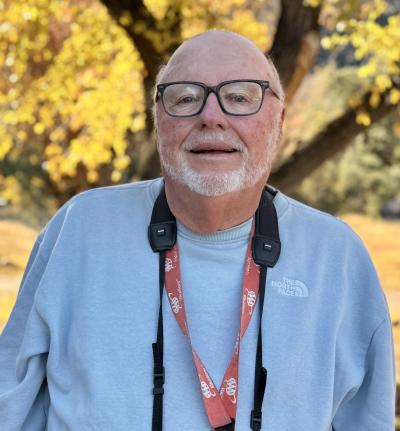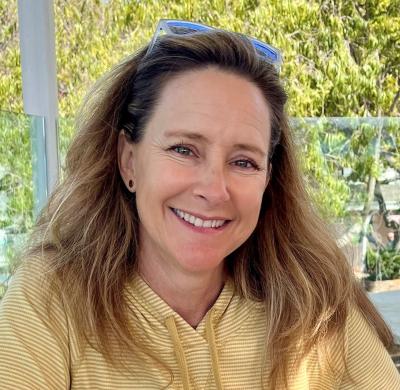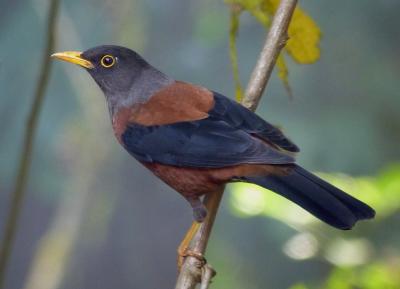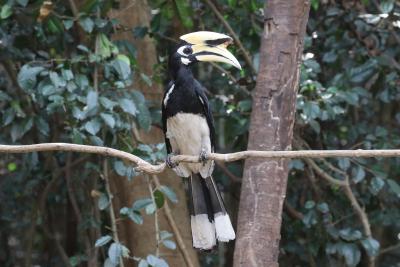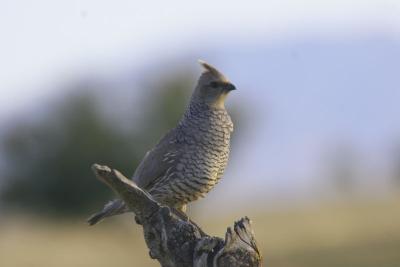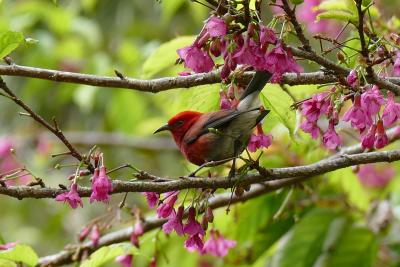Idaho: Cassia Crossbill and Southern Idaho
-
Aug 14-24, 2026
Jon Dunn and Ben Lucking
2026
Single Supplement $1,190
2026
Single Supplement $1,190
In 2017 the AOS Checklist Committee agreed after extensive research by Craig Benkman that the endemic subspecies of Red Crossbill from Idaho’s eastern Twin Falls and Cassia Counties was a full species, the Cassia Crossbill (Loxia sinesciurus). The translation of the species name, sinesciurus, literally means “without squirrels,” and indeed Red Squirrels are absent from the two mountain ranges where this species occurs. The Lodgepole Pine cones there have evolved in the absence of squirrels and so have the crossbills. We’ll spend at least one full day in the heart of the Cassia Crossbill’s range in the South Hills, and we have an excellent chance of both seeing this species and hearing its fairly distinctive calls. In recent years, Cassia Crossbills have been found in the Front Range of Colorado's Rocky Mountains, so one wonders how much that might alter taxonomic considerations.
There is, of course, much more to see in the South Hills, including a variety of montane species, and hummingbirds should be at their peak numbers. In addition, we’ll visit Boise National Forest northeast of Boise with hopes for a fine mix of woodpeckers including possibly black-backed and even American Three-toed, and the sagebrush areas and grasslands around Pocatello where we have a good chance for Ferruginous Hawk, and with luck we might see Burrowing Owl and Prairie Falcon. Our tour coincides with the peak of fall shorebird migration, and we’ll have numerous opportunities to study this compelling group. Idaho is lightly populated, and the scenery will be endlessly spectacular with majestic mountain ranges and verdant and sagebrush covered valleys.
Day 1: The tour begins with an early evening meeting in the lobby of our hotel followed by dinner. Night in Boise.
Day 2: We’ll depart for the beautiful Sawtooth Range in Boise National Forest where our prime ornithological targets are woodpeckers. Some ten species are found here, and we’ll follow the latest reports in our search for key species like White-headed, Black-backed and American Three-toed Woodpeckers. Williamson’s and Red-naped Sapsuckers are also possible, as is Pileated Woodpecker. In addition, we should see coniferous forest species including Canada Jay, Clark’s Nutcracker, Mountain Chickadee, and Red-breasted and White-breasted (interior lagunae subspecies group) Nuthatches and type 2 Red Crossbill. In 2021 we even found a pair of White-winged Crossbills, a three crossbill species tour. Night in Stanley, just to the east of the stunning Sawtooth Mountains.
Day 3: This morning, we will search again for woodpeckers in the Stanley area, notably around Stanley Lake, along with other mountain species including Mountain Bluebirds. Land birds, including early fall migrants are possible, and these could include Western Wood Pewee, Dusky and Olive-sided Flycatchers, Canada Jay and Clark’s Nutcracker, and MacGillivray’s and Nashville (distinctive ridgwayi subspecies) Warbles. In 2024, a pair of Great Gray Owls were in the area and while hiking out to those we stumbled upon the “Franklin’s” subspecies of Spruce Grouse. Sandhill Cranes and Pronghorn should be numerous in the large meadows in the area. Night in Stanley.
Day 4: We’ll spend a few hours birding around Stanley searching for any species we might have missed. Our route today includes spectacular scenery, and we’ll crest several passes—the Galena Summit is nearly 9,000 feet—before descending to the famous Sun Valley ski resort. In 2022 we saw a road killed American Marten indicating the presence of this scarce mammal. Later we will arrive in Twin Falls where after check-in and dinner we might have some time for a bit of birding around the area, notably the falls themselves where we might see White-throated Swift. Night in Twin Falls.
Day 5: We’ll depart Twin Falls for the South Hills, one of the two mountain ranges where the endemic Cassia Crossbill is found. We’ll focus on finding and hearing the distinctive (from other Red Crossbill types) calls on this recently split species. We should see as well many other birds including Common Nighthawk, Western Wood Pewee, Dusky Flycatcher, Black-capped Chickadee, Gray Catbird, Lazuli Bunting, and Yellow-breasted Chat (we should at least hear it) and MacGillivray's Warbler along the streams, and Canyon Wren on the steep cliffs. We’ll also check a local hummingbird feeding station (Brockman’s), where at this time of year dozens of hummingbirds of four species (Black-chinned, Broad-tailed, Rufous and Calliope) are usually present. The nearby beaver ponds have Spotted and Green-tailed Towhees, and “Slate-colored” Fox Sparrow is possible. In one particular burn area we have been successful in seeing numbers of Lewis's Woodpeckers over the last several years. In 2024 we even encountered a family group of Dusky Grouse along the road. In addition to the birds we might see Moose and Mule Deer. This evening, if conditions warrant, we’ll venture back into the South Hills along North Cottonwood Creek to try for Common Poorwill. At a riparian clump along the way various riparian birds nest and migrants are possible and in 2021 Blue Grosbeaks nested. Night in Twin Falls.
Day 6: If we’re completely satisfied with our Cassia Crossbill experiences, we’ll drive south to the southern Magic Valley on the west side of the South Hills. Early in the drive we might see individual or family groups of Gray Partridge along the roadsides as well as a variety of sparrows, including possibly Grasshopper (absent in recent trips) and Brewer’s. In a roadside windbreak of trees we have seen Barn and Great Horned Owls and we’ll watch for Burrowing Owl. We’ll continue farther west to Salmon Falls Creek and Roseworth (Cedar Creek) Reservoir for various water birds, including migrant shorebirds. In the sagebrush areas we should find Sage Thrasher and we have a good chance of seeing Sagebrush Sparrow. Greater Sage-Grouse is found here too, but is very hard to find at this time of year. Then again, in 2024 we had a male walking along side the road! At another grove of junipers along a grassland watercourse we’ll check for Long-eared Owl, and we’ll be watching the sky for a Golden Eagle. On the return to Twin Falls we’ll check ponds where migrant shorebirds are possible depending on the water level. Baird’s, Least, and Western Sandpipers are regular visitors and we have a chance for Solitary Sandpiper and Wilson’s and Red-necked Phalaropes. Both Eastern and Western Kingbirds could be present in the open country or in riparian areas, although most will have departed, and Swainson’s Hawk should be numerous. After a bit of rest and dinner, we might make another try for night birds, notably Common Poorwill. Night in Twin Falls.
Day 7: If for any reason we are still missing Cassia Crossbill, we’ll drive east and south to the Albion Mountains where we have a decent chance of seeing them. Other species might include Clark’s Nutcracker and maybe Williamson’s Sapsucker. White-crowned Sparrows (oriantha) breed here along with Dark-eyed Juncos. Interestingly we found both “Gray-headed” and “Pink-sided” Dark-eyed Juncos, both seeming to be pure phenotypes. Since these likely were breeding birds, it makes one wonder if these two might actually be separate species. Later we’ll continue south to Oakley, not far from the most scenic City of Rocks National Reserve. Night in Almo.
Day 8: This morning we’ll visit the City of Rocks National Reserve. In addition to pinyon-juniper species including Woodhouse’s Jay and with luck roving flocks of Pinyon Jays, we might see Virginia’s and Black-throated Gray Warbler. Juniper Titmice, Blue-gray Gnatcatcher (western subspecies obscura), and perhaps Plumbeous Vireo should be present and we might see Say’s Phoebe and Gray Flycatcher. We’ll also watch for a passing White-throated Swift or a Prairie Falcon. Later, and to the north we’ll visit Lake Wolcott State Park where we’ll have lunch and search for early fall migrants among the Black-capped Chickadee flocks, including Cassin’s Vireo, and Yellow, Wilson’s and perhaps Nashville Warblers (Pacific ridgwayi subspecies). Franklin’s Gulls will be numerous along the river. Later in the afternoon, we’ll stop at American Falls Reservoir which can be good for water birds, including Clark’s and Western Grebes and migrate shorebirds. Night in Pocatello.
Day 9: We’ll spend the morning birding around Pocatello looking for, Chukar, Woodhouse’s Scrub-Jay, Juniper Titmouse and Blue-gray Gnatcatcher all near our hotel. From here we’ll drive south to the Arbon Valley where we should have good chance for Ferruginous Hawk and Prairie Falcon along with a variety of sparrows including Brewer’s and Vesper, and with very good luck, Sharp-tailed Grouse (five seen in 2024.) After a picnic lunch we’ll stop on the way back to Pocatello at Kinney Creek trail in Mink Canyon where we have seen Gray Flycatcher, Plumbeous Vireo, Juniper Titmouse, and on single occasions Ruffed Grouse and Virginia’s Warbler. Night in Pocatello.
Day 10: This morning is flexible depending on what species we may have missed around Pocatello. Not far away is American Falls Reservoir and depending on water levels it can be an excellent location for migrant shorebirds along with hundreds of Franklin’s Gulls and American White Pelicans. Here we have an excellent chance to compare Forster’s and Common Terns. The riparian woodland along the southwest shore of the reservoir can be productive for migrant land birds. From here we’ll drive west via Interstates 86 and 84 and should arrive in Boise by late afternoon. Night in Boise near the airport.
Day 11: The tour concludes after breakfast in Boise.
Note: The information presented below has been extracted from our formal General Information for this tour. It covers topics we feel potential registrants may wish to consider before booking space. The complete General Information for this tour will be sent to all tour registrants and of course supplemental information, if needed, is available from the WINGS office.
Please take a moment to read the About WINGS Tours section of the WINGS website. This section contains important information about how we conduct tours, e.g., what is included in the tour price, refund and cancellation policies, pace of the tours and other information that will help you prepare for the tour.
ENTERING THE UNITED STATES: Non-U.S. citizens will need a valid passport and may need a tourist visa or visa waiver. Please consult your nearest U.S. Embassy or consulate for details. Canadian citizens need to carry proof of citizenship in the form of a passport.
PACE OF THE TOUR: This is a fairly relaxed tour, apart from early mornings (breakfast at 0600), particularly if it is hot, which it certainly can be in August. We drive to nearly all of the birding locations with walking limited at any one spot to about a mile. The pace will always be slow, especially at the higher elevations. There may be owling one or more evenings.
HEALTH: For information on US-based infectious disease outbreaks currently being reported by CDC, please see the CDC Current Outbreak List.
Altitude: We will be at elevations from about 2700’ to about 7000’, although on our second full day we may reach nearly 9000’ at Galena Summit. Unless there is an early cold front, it will likely be somewhat cool in the morning, especially at higher elevations, and then become warm to even hot. It is extremely important to stay hydrated and be alert to the effects of altitude. If there is a cold front it can be quite cool, and indeed cold and perhaps windy (and wet) at higher elevations.
Smoking: Smoking is prohibited in the vehicles or when the group is gathered for meals, checklists, etc. While in the field or traveling, use of a smokeless alternative such as nicotine gum is requested. Please do not smoke at short stops while traveling. If you smoke in the field, do so well away and downwind from the group and leave ample time between smoking and getting back into the vehicle. If you are sharing a room with a non-smoker, please do not smoke in the room. If any lodge, accommodation or location where the group is staying or is gathered has a more restrictive smoking policy than WINGS’ policy, the more restrictive policy will prevail. The leader reserves the right to modify this policy if the situation warrants it.
Participants should bring an adequate supply of any personal medications as they may be difficult to obtain during the tour.
CLIMATE:
It is still quite warm to hot in Idaho in August, unless there is an unexpected early cold front which would bring cooler temperatures and possibly rain, and more likely wind. Thunderstorms are also possible. Lows will be in the 50’s and 60’s (cooler in the mountains) and highs can reach the low to mid- 90’s, though in hotter years temperatures have reached up to the 100’s. In recent years, fires are not infrequent in our western forests in summer and fall. In 2021 it was smoky on several days, the smoke originating from fires in central Oregon.
ACCOMMODATIONS: We will be staying at standard motels and/or lodges throughout the tour. Our hotels offer free wifi access.
FOOD: We’ll eat in a variety of local restaurants where the food will in most cases be American standard. Breakfasts are generally taken in our hotels (continental plus), and lunches will be in local or chain sandwich stores or cafes, or often picnics if the group prefers and if the plan for the day requires this.
WINGS tours are all-inclusive and no refunds can be issued for any tour meals participants choose to skip.
Food Allergies / Requirements: We cannot guarantee that all food allergies can be accommodated at every destination. Participants with significant food allergies or special dietary requirements should bring appropriate foods with them for those times when their needs cannot be met. Announced meal times are always approximate depending on how the day unfolds. Participants who need to eat according to a fixed schedule should bring supplemental food. Please contact the WINGS office if you have any questions.
TRANSPORTATION: We will be traveling by 15- [or 12-] passenger window van or minivan, depending on the group size. When using the larger vans, we will take a maximum of seven passengers plus the leader/driver. Participants should be able to ride in any seat in tour vehicles and will be expected to change seats daily.
2024 Narrative
In Brief:
Our Idaho trip met with good weather and an outstanding variety of birds. We totaled some 189 species, by far our largest trip list for this tour which we ran for the fifth time. We tallied nine species of woodpeckers, including Black-backed, American Three-toed, White-headed, Lewis’s and Williamson’s Sapsucker and four species of grouse (Greater Sage, Dusky, “Franklin’s” Spruce and Sharp-tailed) which was pretty surprising given the time of year when the two of the above species are not at their leks. We obtained our best views ever of Cassia Crossbills in the South Hills and saw a fine variety of shorebirds including scarce species (for Idaho) like three Stilt and one Semipalmated Sandpiper. Our four species of owls included a Great Gray and a half dozen Long-eared. The sagebrush was full of birds, sparrows like Brewer’s, Vesper, and Sagebrush and Sage Thrashers, tallying 50 in a single day. Diurnal raptors included scores of Swainson’s, a few Ferruginous hawks, multiple Prairie Falcons, a Golden Eagle, a Peregrine and a Merlin. We found Gray Partridges relatively numerous this year, and also found a group of Chukars near Pocatello.
In Detail:
We met on the night of August 18th and dined nearby and left the next morning for Idaho City. We stopped along the Boise River for a juvenile American Dipper which surprisingly was a first for our tour. Across the road was a singing Canyon Wren which gave us excellent views. Ospreys were numerous as we drove northeast along the river. Arriving in Idaho City, we went to the home of local birder who kindly allowed us access to her yard. Here we saw a number of species including Black-chinned and Rufous Hummingbirds and Cassin’s Finches. Most importantly we saw a female White-headed Woodpecker, a scarce species in Idaho and here at the eastern most part of its range which is mainly in California, Oregon and Washington. From here we drove northeast which carried us over several passes. Species of note included Dusky Flycatcher, Cassin’s Vireo (only heard singing), Clark’s Nutcracker, Red Crossbills (type 2), a juvenile Townsend’s Solitaire, Mountain Bluebirds (the state bird for Idaho, and Nevada), Western Tanager, Lazuli Bunting, and Pine Siskins. Our most notable sighting was a male Black-backed Woodpecker but we also had a male California Quail sitting up on a rock! Later and closer to Stanley at the Vader Creek burn we found a female American Three-toed Woodpecker, the very place where we had a female on our last trip two years ago (same bird?) We recorded seven species of woodpeckers for the day. A few Yellow-pine Chipmunks were noted, as well.
Later and after checking-in to our lodge, we were joined by another local friend and birder who took us out to a meadow edge where she had earlier found a family of Great Gray Owls. On our way out, about a mile hike, we saw a female Williamson’s Sapsucker and a Mountain Chickadee. On approaching the wooded area bordering the meadow we had brief views of the adult Great Gray and also heard it hoot, but it was then out of sight. We eventually worked around for closer views, and on the way flushed up a male Spruce Grouse. Both the owl and the grouse were the first ones we had located on our tours, the Spruce Grouse being only the third one that locals have seen in this part of Idaho. The grouse walked out onto a log giving us outstanding views. This was a “Franklin’s Grouse” which is confined to the northwestern part of North America. It is recognizable by the lack of a rufous tail band and particularly by the broad and contrasting white tips to the upper tail-coverts. Some recommend that it be recognized as its own species but there is an intermediate (from widespread nominate canadensis) subspecies, isleibi which is found on Prince of Wales Island and adjacent smaller islands in Southeast Alaska. There may be behavioral differences too and it seems likely that the taxonomic treatment will be further studied. We then located the perched Great Gray and got excellent scope views. Along the edge of the meadow we noted Lincoln’s and White-crowned (oriantha subspecies) sparrows. On our hike out at dusk, a herd of Pronghorn moved across the meadow. We had a late dinner and all in all it had been a remarkable day.
The next morning started with a short walk to the Stanley Baking Company for a delicious breakfast. We then headed towards Lake Stanley checking one wooded area nearby where we located a small party of Canada Jays. We took a short hike at the northwest corner of the lake and noted a small party of Ring-necked Ducks and a larger group of sitting Common Mergansers on the beach. Other species of note included several Olive-sided Flycatchers and Western Wood Pewees, Warbling Vireos, Clark’s Nutcrackers, Mountain Chickadees and Western Tanagers. We had excellent views of a colorful adult male Townsend’s Warbler, a fall migrant, and brief views of a Brown Creeper, our only one. Heading south we stopped at the Stanley Ranger Station sewage ponds where we noted a Bufflehead, a Ruddy Duck, a family group of Lesser Scaup, several Spotted, Baird’s and Least Sandpipers and a cooperative juvenile Solitary Sandpiper which showed buffy-cinnamon spotting above, indicative of the western subspecies, cinnamomea. It is the juvenal plumage which is most easily separable to subspecies. In the eastern subspecies, solitaria, the spotting above is white in all plumages. A summering Trumpeter Swan was also present.
As we headed south we noted a number of Sandhill Cranes, some of which were close to the road. We checked a large burn area down near Galena Summit (Smiley Creek), but the only woodpecker of note was a female Williamson’s Sapsucker. On the other side of the pass we had lunch where we noted a family group of Dusky Flycatchers. From here we traveled south through the populated area of Ketchum (the popular ski resort of Sun Valley is here) and headed down to Hot Springs Landing at Magic Reservoir. Here we met Pat Weber of Prairie Falcon Audubon, and she expertly co-led us for the next four days. At Magic Reservoir we noted a scattering of Baird’s Sandpipers but also noted a juvenile Semipalmated Plover, an adult Red-necked Phalarope, Lesser Yellowlegs (three juveniles), Long-billed Dowitchers (two) and Wilson’s Snipes. Both Clark’s and Western Grebes were also present. Our last stop was Silver Creek Preserve where we saw Marsh Wrens and heard Virginia Rails. Eastern and Western Kingbirds were also present. At the headquarters, numerous migrant land birds were present. These included a number of Warbling Vireos and Western Tanagers along with Willow Flycatchers, a single Gray Flycatcher, and Yellow Warblers.
The next morning we ventured up into the South Hills from the north side. On the way we stopped alongside a flooded field where we studied several Solitary Sandpipers, some 25 Wilson’s Snipes and several Yellow-headed Blackbirds. 15 Swainson’s Hawks were noted here and elsewhere in the farmland. As we entered the South Hills, we made a few stops on the way up noting a Lewis’s Woodpecker, several “Slate-colored Fox Sparrows,” two MacGillivray’s Warblers and two Yellow-breasted Chats, all seen very well. A Gray Catbird was heard. Just up canyon we were fortunate to have a family group of Dusky Grouse along the side of the road and they remained for leisurely studies from the van. A few Common Nighthawks were also noted nearby and a Belted Kingfisher made several passes. The main goal of the day was locating the now split Cassia Crossbill. This took until lunchtime, although we heard one earlier. Other species noted included Sharp-shinned and Cooper’s hawks, a dozen Lewis’s and five Hairy woodpeckers, a juvenile Red-naped and a male Williamson’s Sapsucker, Olive-sided and Dusky flycatchers and Western Wood Pewees, House and Rock Wrens, Red-breasted Nuthatches and a dozen Dark-eyed (“Gray-headed” subspecies) Juncos. A dozen Northern Flickers were also tallied and in all we recorded nine species of woodpeckers, missing only the scarce (in Idaho) Pileated.
While having lunch at Diamond Field Jack Campground, Pat Weber wandered over to a water seep and located seven perched Cassia Crossbills! Fortunately, they remained for extended close studies and photographs. It was thought that this now recognized species was restricted to the South Hills and the Albion Mountains to the east, but they have now been found in the Front Range of Colorado’s Rocky Mountains. A Moose was also present very close by, one of three we saw during the day, including a calf. After lunch we headed to Brockman’s Bar, a well-known spot to all where many hummingbird feeders have been set up. We saw many individuals of four species (Black-chinned, presumably Rufous, a few Calliopes and Broad-tailed, including one or more adult males giving their loud trilling calls). A few Sage Thrashers were seen on the drive. Later and after dinner at a delicious Thai restaurant in Twin Falls we drove to another shallow canyon in South Hills where we eventually had outstanding views of a Common Poorwill sitting on the dirt road.
The next morning we drove southwest to the sagebrush country on the west side of the South Hills. Here we saw many sparrows: Brewer’s, Vesper, two Savannah and eventually four Sagebrush along with several dozen Horned Larks, some 50 Sage Thrashers, 100+ Western Meadowlarks, a Say’s Phoebe, three Rock Wrens, and seven Loggerhead Shrikes. Raptors were numerous and our count for the day was 76 Swainson’s Hawks. In addition to numerous Red-tails and nine Northern Harriers, we also had excellent studies of three Ferruginous Hawks along with three Prairie Falcons and a single juvenile Peregrine Falcon. A family group of Ring-necked Pheasants were noted as well as 22 Gray Partridges. Owls noted during the day included a Barn Owl and two Burrowing Owls along with sadly two fresh road killed birds. Later and after lunch we located a roosting group of six Long-eared Owls in grove of juniper trees. We checked a few bodies of water. At a small pond we saw our only Pied-billed Grebe, a juvenile and our only Blue-winged Teal. Other water birds seen included American White Pelicans (16) White-faced Ibis (89), many puddle ducks, Common Merganser (36), a single Caspian Tern, and a flock of 50 Red-necked Phalaropes, which were in tight formation in twisting flight as the Peregrine was pursuing them. Some 40 Pronghorn were counted. An indication that things worked out well was at one point we missed a turn to the west on our sojourn and continued southeast towards the South Hills for another mile or so. We corrected and turned around and on the return, one in the group spoke up and said stop. We had passed a large chicken. Turning around again we located it and it was a male Greater Sage-Grouse walking along the edge of a fence and looking about as big as a barn! I was rather amazed that the rest of us had missed it! This species is certainly threatened and would probably best be considered endangered if it were not for political considerations. This was the first time we have seen this species on the tour. It is more easily located in the spring when they are on leks, but they are always difficult to locate at other times of the year. We spent a long period of time following it in the van as it strolled along the edge of the sagebrush. Always fun when we have a group with good spotting skills! That evening we enjoyed a fine dinner overlooking the Snake River Canyon in Twin Falls.
We left our hotel in Twin Falls early this morning and headed southeast. A family group of Ring-necked Pheasants were seen along the way. Our first stop was at Hanson Ponds where there was a fine variety of waterfowl and shorebirds. The waterfowl included three newly arrived American Wigeon. Shorebirds included Black-necked Stilts and American Avocets, Lesser and Greater yellowlegs, Solitary Sandpipers, and Red-necked and Wilson’s Phalaropes. Rare species included three juvenile Stilt Sandpipers and a juvenile Semipalmated Sandpiper. Five Black-crowned Night-Herons were also noted along with more Great Blues and several dozen Yellow-headed Blackbirds. Here and nearby we tallied some 700 Franklin’s Gulls along with smaller numbers of Ring-billed and California Gulls. At Murtaugh Lake we had excellent flight comparisons of two Common Terns along with some 17 Forster’s Terns. From here we tracked southeast. We stopped at Cottonwood WMA where there were numerous (introduced) Wild Turkeys. We took lunch in the Albion Mountains and did some birding noting two Clark’s Nutcrackers and many Chipping (some 200) along with a few Brewer’s and White-crowned (oriantha) sparrows, Lazuli Buntings and Orange-crowned Warblers. Yellow-rumped (“Audubon’s”) Warblers were common. We did not find more Cassia Crossbills, but had excellent views of an adult Golden Eagle that flew overhead, our only one of the tour. From here we headed south to Almo where we stayed at the very nice Almo Hotel, a place that looked like a set for a western movie. At the hummingbird feeders at our dining spot, there were two Calliope Hummingbirds with the more numerous Black-chinned. A short drive away was Smoky Mountain Campground with extensive stands of pinyon pines. Here we found small numbers of passerines which included multiple Black-throated Gray Warblers here not far from the northeast end of their breeding range. This is the first time we’ve found this striking wood warbler on our tour. Also present were Juniper Titmice, Blue-gray Gnatcatchers and a Plumbeous Vireo. Other speces noted during the day were numerous Mountain Bluebirds, 40 Swainson’s Hawks, two Prairie Falcons, two Loggerhead Shrikes and a Gray Flycatcher. Dinner that night was at the Almo Outpost, within a hundred yards of our rooms.
This morning after breakfast in the rooms, we visited Castle Rocks State Park. We stopped along the way at a water tank where Pinyon Jays were visiting in small numbers to drink. We had good views and good audibles as well. They are talkative. We heard, but did not see, Woodhouse’s Scrub-Jay. We also noted several groups of Gray Partridges. Along the trails we noted two Green-tailed Towhees and two Blue-gray Gnatcatchers. Back at the feeders across from the hotel we tallied some nine Black-chinned along with a single Calliope Hummingbird. Here at Almo we said our goodbyes and expressed our thanks to Pat who had kindly joined our tour for four days and generously shared her extensive knowledge about the birds around Twin Falls and Almo. Pat is president of the Prairie Falcon Audubon Society and wages many important conservation battles for which there are many in Idaho.
From Almo we headed north to Burley. Along the way a Prairie Falcon was seen and we tallied 22 American Kestrels for the day. A strong thunderstorm also arrived with wind and torrential rain. We took shelter and lunch at close-by Mexican restaurant, and then continued up to Lake Wolcott State Park. The storm had just passed north when we arrived. Along the Snake River we had close-up views of Franklin’s Gulls and a number of Common and Forster’s Terns along with American White Pelicans and Double-crested Cormorants and several Ospreys. In the trees at the state park we found numerous migrants amongst the Black-capped Chickadee flocks. These included a Cassin’s Vireo, two Nashville Warblers (Pacific subspecies ridgway, the “Calaveras Warbler,” which might well be a separate species), and three Towsend’s and a Wilson’s Warbler along with numerous Yellows. Our final stop was at American Falls Reservoir where we checked the shoreline near Willow Bay Resort. There was a moderate sized flock of Western and Baird’s Sandpipers and we wandered down for very close views and comparisons. A juvenile Semipalmated Plover was also present. We arrived at our lodging in Pocatello for the evening and took dinner in town.
The next morning we looked without success for Chukar near our hotel and then continued south to Cherry Springs in the hills where there were many migrants, many clearly on the move. These included an astounding 50 Warbling Vireos, probably more than I’ve ever seen in my life at one location. These birds were mostly just moving south up canyon in small parties. Other species noted included several Red-naped Sapsuckers, Black-capped and Mountain Chickadees together, five Cedar Waxwings, our only Black-headed Grosbeak (flight views), Western Tanagers, Blue-gray Gnatcatchers, two Gray Catbirds, our only Swainson’s Thrush, 10 Yellow Warblers and two Lazuli Buntings. From here we continued on southwest to the beautiful Arbon Valley, a relatively remote area which is excellent for raptors. We had excellent studies of one, or two, Ferruginous Hawks, a Sharp-shinned, two Cooper’s, and five Northern Harriers along with a Prairie Falcon and a briefly seen southbound Merlin. Sparrows were abundant and included 28 Vespers and 70 Brewer’s some of which were seen exceptionally well. Mountain Bluebirds (47) and Horned Larks (70) were very common. We also noted a pair of Sandhill Cranes, three Say’s Phoebes, and two Long-billed Curlews, a species which could likely nest here, but most have headed south, or southwest, mainly to California. Our main target was Sharp-tailed Grouse which is a resident here, but again this is a lekking species so is elusive and very difficult to find at this time of year. In the spring they are on the dancing grounds. This year we finally had a chance to check out a local place that was recommended a few years back, and we parked at the edge of the field and walked out several hundred yards. To our surprise, five Sharp-tailed Grouse flushed from the field. We all got flight views and a few mediocre, but identifiable photos. It was our fourth grouse species of the tour, a rather remarkable feat, and likely not to be repeated. A 5th species, Ruffed, is also possible and in fact we have had it twice previously (South Hills and near Pocatello), but we did not encounter one this year. On our way back to Pocatello we stopped at Scout Mountain, a purported place for Steller’s Jay. We found none and hardly any other birds which is what I experienced on my last visit there. We again checked the pinyon-juniper habitat and looked for Chukars and jays. We found neither. That night we had dinner at an excellent place close to the hotel, Jaker’s of Pocatello.
The next morning we again looked for jays and chickens. We located a Woodhouse’s Scrub-Jay finally and had excellent views. We tallied four birds. A Wild Turkey was also seen and a Juniper Titmouse was heard. Returning to the Chukar location, I initially thought we had located them, but they turned out to be a covey of Gray Partridges. We carefully examined them. One hopes to always learn something from our mistakes. We continued up the road to China Peak and at 1.2 miles pulled off into a pullout. We heard Chukars! We then found them and eventually got good views of a multi-family group of 18. From here we headed back to the hotel, checked out and headed down to the American Falls Reservoir. We stopped at the dam. A cold front had arrived and the winds were strong. Swallows were abundant and were sitting on the pavement of the dam. We estimated some 600 Bank Swallows! There were also some 50 Western and seven Clark’s Grebes along with another 50 Aecmophorus grebe sp. We then returned to the beach near Willow Bay Resort and walked towards the dam. Shorebirds were numerous and included four Black-necked Stilts, 24 Baird’s and six Western sandpipers (all juveniles for both species), three juvenile Willets, 20 Lesser Yellowlegs (all juveniles), six juvenile Marbled Godwits and a juvenile Long-billed Curlew with a short bill like a Whimbrel but easily separable on coloration and head pattern. A Whimbrel would be very rare in Idaho, particularly in the fall. Two adult Black-bellied Plovers in breeding plumage were our first ones for our Idaho tour. Other species noted included six Great Egrets, 75 American White Pelicans, small numbers of Common and Forster’s along with four Caspian Terns, a sub-adult Bald Eagle, a Common Loon (a one year old bird in a winter-like plumage), three Redheads, and Savannah and Vesper sparrows. During the day we also noted an Olive-sided Flycatcher, 55 Swainson’s and four Cooper’s hawks and 30 California Quail (this is an introduced species to Idaho, but long-established). We also noted a Mule Deer and a Coyote.
After a picnic lunch at an interstate rest stop we decided to check a place on the way back to Boise for Western Bluebird. It was at a place where there had been sightings, albeit not this year! But there were bluebird boxes so we were hopeful. They were near the very small community of Prairie and it was reached by a long and twisty road, but with beautiful scenery. Ben looked at all of the places with sightings and put a pin on where he felt might be the best location. Along the way we saw very few birds and eventually came to Prairie and continued on to the pin. And then, within 15 feet of the pin were a pair of Western Bluebirds, our only ones of the tour and only the 2nd time we have recorded the species on an Idaho tour, the latter occasion was in Idaho City later in September. Amazing Ben! On our drive west back to Boise we continued to admire the spectacular scenery. At a gorge we noted some 40 Violet-green Swallows. The habitat looked perfect for White-throated Swifts too but we did not find them. We arrived back in Boise and took our last dinner near our hotel. Departures for some of us were in the predawn the next day.
My sincere thanks to Pat Weber and Lauren Brockway, and in absentia to Jennifer Alban and Jerre and Toni Evans for all of their generous contributions of local information which enabled us to see so many special birds, and to Ben for all of his eBird checklists, keeping track of what others were seeing on eBird and for all of his assistance throughout. Lastly, I want to thank the group for making the trip so memorable and fun.
- Jon L. Dunn, 2024
Maximum group size is nine with two leaders.






















